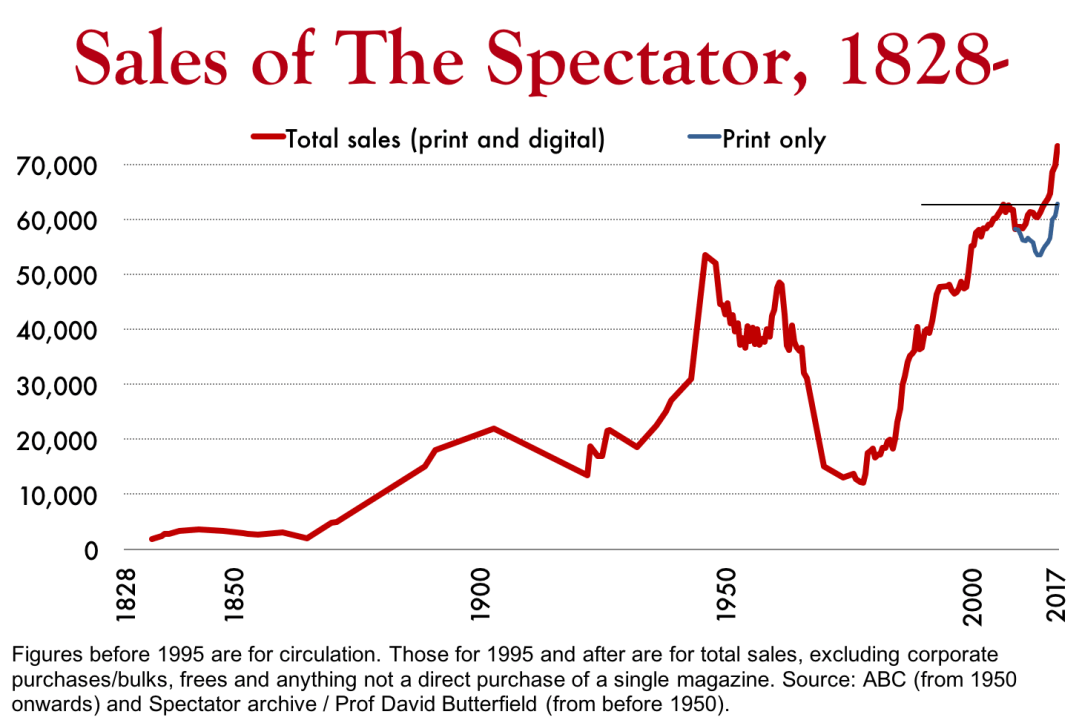The magazine industry releases annual circulation figures today and the results for The Spectator are historic in two ways. First: our sales are at a record high, at 73,328, which is quite something for the world’s oldest weekly magazine. But we can today announce something I never thought I’d say: sales of the print magazine have now surpassed their 2006 peak to hit a new all-time high of 62,940. The Spectator celebrates its 190th birthday in July and will soon become the first weekly in history to print a 10,000th edition. Never in our long history have more people been reading (and, more importantly, buying) the print magazine. Our archivist, Prof David Butterfield, has been building a sales chart dating back to our first issue in July 1828. It’s above. At the end, the line splits between total sales (ie, including digital-only) and beneath it, print-only. Our story since 1950 is below – showing how Alexander Chancellor (who died this time last year) saved the magazine.

Our UK subscriptions went up 11 per cent last year, our fastest rise for a decade. And digital is behind the renaissance of print. The website brings millions of people to The Spectator and they can read two articles a week before being invited to subscribe for full access. When they do, the vast majority choose our print and digital package. At £12 for a three-month trial, it’s a no-brainer. Then, those who never thought they’d get into the habit of reading a print magazine find that they’re hooked: drawn in to stories by Morten Morland’s illustrations, the photography, the pull-quotes. The joy of a magazine is stumbling across new stories, finding the quality of writing draws you in to a subject that normally bores you. The vast majority of those on a trial subscription move on to a full subscription.
It’s always the same story: people assume The Spectator is just about politics, then pick it up to find it’s about differing opinions, the lost art of civil disagreement. It’s about ideas, books, culture, and the treasures such as Dear Mary and our Life section. Once you try a few copies, the odds are you’ll conclude that life’s too short not to read The Spectator.
So digital is not a threat to print. In our experience, digital has led to renaissance of print. Not just in the website, but social media and our range of podcasts, which now achieve over 100,000 listens every week. Digital means we can easily sell tickets to our events: no publication does them better, and we now lay on more events each year than we print issues of the magazine. Digital means that you’re reading this now – and, if you’re not a subscriber, perhaps, you’re wondering what the fuss is about. Well you can try the print magazine for yourself: £12 for three months by clicking here.
PS All of the figures above are for sales: ie, people buying the magazine. There are many other forms of circulation: the more discerning airlines, for example, buy The Spectator for their passengers. ABC, the organisation that audits and compiles magazine figures, gives us a “gross” figure of worldwide figure which includes frees, bulks and “allowable bundles” (ie, print/digital subscriptions that ABC counts as two subscriptions.) So the ABC headline on our worldwide sales is 93,677 (full details here). But we prefer to judge ourselves by the sales figure (graph above) which stands at a record high without the need for giveaways.
This article is free to read
To unlock more articles, subscribe to get 3 months of unlimited access for just $5









Comments
Join the debate for just $5 for 3 months
Be part of the conversation with other Spectator readers by getting your first three months for $5.
UNLOCK ACCESS Just $5 for 3 monthsAlready a subscriber? Log in